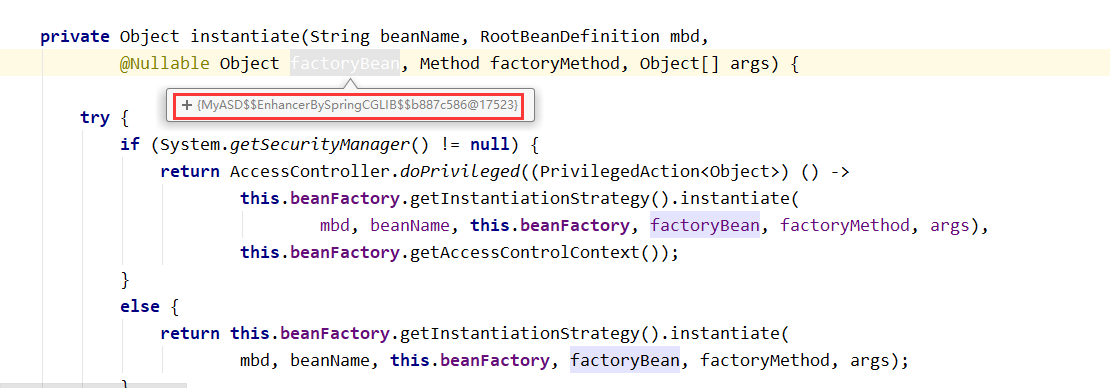项目里出现两个配置类继承WebMvcConfigurationSupport时,为什么只有一个会生效(源码分析)
为什么我们的项目里出现两个配置类继承WebMvcConfigurationSupport时,只有一个会生效。我在网上找了半天都是说结果的,没有人分析源码到底是为啥,博主准备讲解一下,希望可以帮到大家!
大家基本遇到过一种情况,就是我配置类中已经配置了,为什么就是没有生效呢?其中一种原因就是,自己写的配置类也继承了WebMvcConfigurationSupport,当项目出现两个配置类都继承该类时,只会讲第一个配置类生效,至于为什么,就是今天博主需要讲解的,我们必须了解一些springboot的bean的创建过程也就是其生命周期:
https://www.processon.com/view/link/5f704050f346fb166d0f3e3c
虽然画的比较简单,有许多细节都没有解析,但是对于当前我们的话题来讲已经基本可以了;
第一步:我们的配置类是从哪里开始创建解析的:大家可以看到图示bean的流程中doProcessConfigurationClass(configClass, sourceClass, filter);方法,我们看一下是如何调用它 的:
protected void processConfigurationClass(ConfigurationClass configClass, Predicate<String> filter) throws IOException {
if (this.conditionEvaluator.shouldSkip(configClass.getMetadata(), ConfigurationPhase.PARSE_CONFIGURATION)) {
return;
}
ConfigurationClass existingClass = this.configurationClasses.get(configClass);
if (existingClass != null) {
if (configClass.isImported()) {
if (existingClass.isImported()) {
existingClass.mergeImportedBy(configClass);
}
// Otherwise ignore new imported config class; existing non-imported class overrides it.
return;
}
else {
// Explicit bean definition found, probably replacing an import.
// Let's remove the old one and go with the new one.
this.configurationClasses.remove(configClass);
this.knownSuperclasses.values().removeIf(configClass::equals);
}
}
// Recursively process the configuration class and its superclass hierarchy.
SourceClass sourceClass = asSourceClass(configClass, filter);
do {
//从这里开始解析我们的当前配置类
sourceClass = doProcessConfigurationClass(configClass, sourceClass, filter);
}
while (sourceClass != null);
this.configurationClasses.put(configClass, configClass);
}
这里可以看到一个while循环,为什么要这么设计呢?我们再看看doProcessConfigurationClass(configClass, sourceClass, filter);方法的源码
protected final SourceClass doProcessConfigurationClass(
ConfigurationClass configClass, SourceClass sourceClass, Predicate<String> filter)
throws IOException {
if (configClass.getMetadata().isAnnotated(Component.class.getName())) {
// Recursively process any member (nested) classes first
processMemberClasses(configClass, sourceClass, filter);
}
// Process any @PropertySource annotations
for (AnnotationAttributes propertySource : AnnotationConfigUtils.attributesForRepeatable(
sourceClass.getMetadata(), PropertySources.class,
org.springframework.context.annotation.PropertySource.class)) {
if (this.environment instanceof ConfigurableEnvironment) {
processPropertySource(propertySource);
}
else {
logger.info("Ignoring @PropertySource annotation on [" + sourceClass.getMetadata().getClassName() +
"]. Reason: Environment must implement ConfigurableEnvironment");
}
}
// Process any @ComponentScan annotations
Set<AnnotationAttributes> componentScans = AnnotationConfigUtils.attributesForRepeatable(
sourceClass.getMetadata(), ComponentScans.class, ComponentScan.class);
if (!componentScans.isEmpty() &&
!this.conditionEvaluator.shouldSkip(sourceClass.getMetadata(), ConfigurationPhase.REGISTER_BEAN)) {
for (AnnotationAttributes componentScan : componentScans) {
// The config class is annotated with @ComponentScan -> perform the scan immediately
Set<BeanDefinitionHolder> scannedBeanDefinitions =
this.componentScanParser.parse(componentScan, sourceClass.getMetadata().getClassName());
// Check the set of scanned definitions for any further config classes and parse recursively if needed
for (BeanDefinitionHolder holder : scannedBeanDefinitions) {
BeanDefinition bdCand = holder.getBeanDefinition().getOriginatingBeanDefinition();
if (bdCand == null) {
bdCand = holder.getBeanDefinition();
}
if (ConfigurationClassUtils.checkConfigurationClassCandidate(bdCand, this.metadataReaderFactory)) {
parse(bdCand.getBeanClassName(), holder.getBeanName());
}
}
}
}
// Process any @Import annotations
processImports(configClass, sourceClass, getImports(sourceClass), filter, true);
// Process any @ImportResource annotations
AnnotationAttributes importResource =
AnnotationConfigUtils.attributesFor(sourceClass.getMetadata(), ImportResource.class);
if (importResource != null) {
String[] resources = importResource.getStringArray("locations");
Class<? extends BeanDefinitionReader> readerClass = importResource.getClass("reader");
for (String resource : resources) {
String resolvedResource = this.environment.resolveRequiredPlaceholders(resource);
configClass.addImportedResource(resolvedResource, readerClass);
}
}
//这里也很重要,这里开始会解析当前配置类里的bean,然后解析父类里面的bean,就是这里才会把WebMvcConfigurationSupport的所有bean
//都解析出来并添加到configClass里面,不管解析当前类还是父类,configClass都是自己当前的配置类,所以WebMvcConfigurationSupport
// Process individual @Bean methods
Set<MethodMetadata> beanMethods = retrieveBeanMethodMetadata(sourceClass);
for (MethodMetadata methodMetadata : beanMethods) {
configClass.addBeanMethod(new BeanMethod(methodMetadata, configClass));
}
// Process default methods on interfaces
processInterfaces(configClass, sourceClass);
//最主要的就是这里,解析当前类的父类
// Process superclass, if any
if (sourceClass.getMetadata().hasSuperClass()) {
String superclass = sourceClass.getMetadata().getSuperClassName();
if (superclass != null && !superclass.startsWith("java") &&
!this.knownSuperclasses.containsKey(superclass)) {
//如果我们第一个继承了WebMvcConfigurationSupport的配置类,已经被扫描到,就会添加一个map缓存,
//下一个也继承了WebMvcConfigurationSupport的配置类,将不在解析,直接返回null。结束循环,这也是外面一层为什么要添加while循环
this.knownSuperclasses.put(superclass, configClass);
// Superclass found, return its annotation metadata and recurse
return sourceClass.getSuperClass();
}
}
// No superclass -> processing is complete
return null;
所以就现在来讲,基本已经决定了,解析第一个配置类的时候,第二个配置类重写的任何方法基本没什么用了,因为父类所有的bean已经在第一个配置类中解析扫描到了,就剩下如何去创建bean了。我们再继续往下看会更明白;
第二步:现在当所有bean已经扫描到,并且bean定义已经完成,该开始实例化了,看一下createBeanInstance的创建过程,最后生成的时候会找到 factoryBean也就是我们自己的配置类
private Object instantiate(String beanName, RootBeanDefinition mbd,
@Nullable Object factoryBean, Method factoryMethod, Object[] args) {
try {
if (System.getSecurityManager() != null) {
return AccessController.doPrivileged((PrivilegedAction<Object>) () ->
this.beanFactory.getInstantiationStrategy().instantiate(
mbd, beanName, this.beanFactory, factoryBean, factoryMethod, args),
this.beanFactory.getAccessControlContext());
}
else {
return this.beanFactory.getInstantiationStrategy().instantiate(
mbd, beanName, this.beanFactory, factoryBean, factoryMethod, args);
}
}
catch (Throwable ex) {
throw new BeanCreationException(mbd.getResourceDescription(), beanName,
"Bean instantiation via factory method failed", ex);
}
}
其中factoryBean就是我们的当前第一个被解析到的配置类bean,截图为证,我自己写了两个配置类,第一个被加载的是MyASD,瞎写的名,好区分,第二个配置类是WebConfiguration,我们只看WebMvcConfigurationSupport里面的其中一个bean的创建过程,就是requestMappingHandlerAdapter,为啥要看这个,正好跟上节json自定义衔接。
https://www.cnblogs.com/guoxiaoyu/p/13667961.html

到这里,我们可以看到在生成requestMappingHandlerAdapter时,调用extendMessageConverters方法时,一定会调用第一个配置类中的重写方法,因为所有的WebMvcConfigurationSupport里面 bean都被第一个配置类解析完了,所有的factoryBean都是当前第一个配置类,就算第二个配置完没有报错,也不会生效了。
我直接把这个问题用源码的方式讲解清楚,方便大家明白为什么配置两个WebMvcConfigurationSupport类,只有一个生效。
- 点赞
- 收藏
- 关注作者


评论(0)